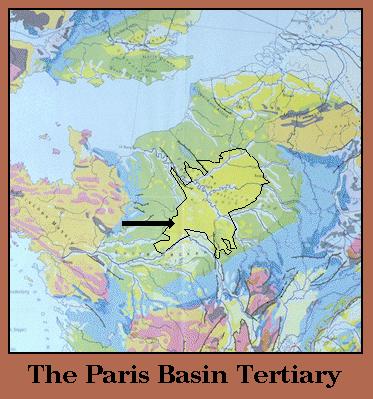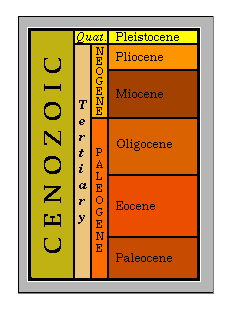



The Cenozoic is divided into two main sub-divisions: the Tertiary and the Quaternary. Most of the Cenozoic is the Tertiary, from 65 million years ago to 1.8 million years ago. The Quaternary includes only the last 1.8 million years.
The concepts of Tertiary and Quaternary have an interesting history. In the 1760's and 1770's a geologist named Giovanni Arduino was studying the rocks and minerals in Tuscany. He classified mountains according to the type of rocks that he found in them. Unfossiliferous schists, granites, and basalts (all volcanic rocks) that formed the cores of large mountains he called Primitive. Fossil rich rocks of limestone and clay that were found on the flanks of mountains over the Primitive rocks were called Secondary. Finally, there were another group of fossiliferous rocks of limestones and sandstones lying over the Secondary rocks and forming the foothills of the mountains that Anduino called Tertiary. At first, then, Tertiary referred to a certain type of rock found in the area of Tuscany. Later, however, geologists used the fossils found in the Tertiary rocks there to recognize rocks of the same age elsewhere. Rocks with the same species of fossils were the same age.

Extensive Tertiary age rocks were recognized in the Paris Basin, which is the area around Paris, France. In the 1820's and 1830's Charles Lyell, a noted English geologist who had a great influence on Charles Darwin, subdivided the Tertiary rocks of the Paris Basin on their fossils. Lyell came up with an ingenious idea. He noticed that the rocks at the top of the section had a very high percentage of fossils of living mollusc species. Those at the bottom of the section had very few living forms. He deduced that this difference was because of the extinction of older forms and the evolution of living forms during the time that the rocks were being deposited. He divided the Tertiary rocks into three sub-ages: the Pliocene, the Miocene, and the Eocene. 90% of the fossil molluscs in Pliocene rocks were living today. In the Miocene rocks, only 18% of the molluscs were of living species, and in Eocene rocks, only 9.5%.
These subdivisions of the Tertiary have been correlated around the world using the fossil species in them. Rocks with the same species as Lyell's Eocene, are considered to be the same age as those in the Paris Basin. The same goes for the other subdivisions. Some time later it was noted that in areas other than the Paris Basin, there were rocks that seemed to be from time periods that were not represented in Lyell's sequence. This was because during those periods there had been no deposition in what would later be the Paris Basin. These two periods, later designated Oligocene and Paleocene, were inserted into the Tertiary in their proper places.
 |
Cenozoic to visit its exhibit! The chart at left shows the several subdivisions of the Cenozoic Era. After the column labelled "Cenozoic", the next column shows the two periods, the Tertiary and the Quaternary. The Tertiary Period is subdivided into the Paleogene and the Neogene, though we have not created exhibits for these divisions. The right-hand column lists the six major epochs into which the periods are divided. You may click on any of these to visit our exhibit on that epoch. A separate seventh period is often recognized for the last 11,000 years, and is called the Holocene. |
Find out more about the Cenozoic paleontology and geology of North America at the Paleontology Portal.


